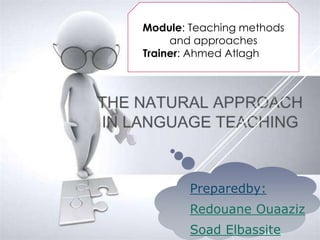
The natural approach
- 1. Preparedby: Redouane Ouaaziz Soad Elbassite Module: Teaching methods and approaches Trainer: Ahmed Atlagh
- 2. NATURAL APPROACH Briefly intoduced Overview Aims Theories of language Principles Roles of Teacher & Learner Materials/ activities Techniques Advs/ Disadvs Video
- 3. DEFINITION Is a language teaching approach which claims that language learning is a reproduction of the way humans naturally acquire their native language.
- 4. OVERVIEW It was developed and published as a book by Mr. Stephen Krashen and Tracy Terrell in 1983. In the book, Mr. Krashen and Mrs. Terrell consider their approach as a traditional method.
- 5. OVERVIEW Natural Approach believes that adults can still acquire second languages. The ability of language acquisition does not disappear as we grow up. Adults also acquire language by following the principles of Universal Grammar.
- 6. OVERVIEW The difference between adult and children acquisition skill is that adults have two things to follow when they learn foreign language: Acquisition and learning. But, children only acquire the languages.
- 7. AIMS To help adults in learning the foreign language naturally. The learner will be able to pick up the grammar by themselves when they are ready.
- 8. THEORIES The Acquisition-Learning hypothesis The learner has two ways of learning the second language, which are the acquired system and the learned system.
- 9. THEORIES The monitor hypothesis When the learner can check and correct language output.
- 10. THEORIES The Natural Order hypothesis When people acquire language by using grammatical structures in a predictable order.
- 11. THEORIES The input hypothesis People aquire language best when they are given input slightly beyond their current level i+1.
- 12. The Affective Filter hypothesis Three states are to be identified: Motivation: learners with high motivation generally do better. Self-confidence: learners with self- confidence and a good self-image tend to be more successful. Anxiety: Low personal anxiety and low classroom anxiety are more conducive to second language acquisition. THEORIES
- 13. PRINCIPLES "Focus of instruction is on communication rather than its form.“ "Speech production comes slowly and is never forced.“ "Early speech goes through natural stages (yes or no response, one- word answers, lists of words, short phrases, complete sentences.)"
- 14. TEACHER´S ROLE Act as an authority in the class Imitate the first language learning process Creatively instruct students to do activities that benefit the language learning.
- 15. LEARNER´S ROLE Pre-production stage: learners participate in the language activity without having to respond. Early-production stage: learners answer questions, with single words and short phrases. Speech-emergent stage: learners involve themselves in role plays, games and other activities.
- 16. NSTRUCTIONAL MATERIALS Make classroom activities as meaningful as possible and promote comprehension, and The primary aim of materials is to promote comprehension and communication. Pictures and other visual aids are essential, because they supply the content for communication Materials come from the world of realia rather than from textbooks.
- 17. ACTIVITIES For beginners: Pointing, handing objects, writing or drawing , standing, walking, sitting down For advanced learners: Like listening and reading tasks that learners order pictures, follow written instruction or maps.
- 18. TECHNIQUES pictures, objects Mime/ commands Body language Audio-visual aids Memorizing games
- 19. STRENGTHS & WEAKNESSES Strengths This method is very easy. Reliable as it’s widely used There’s no grammar instruction in this method.
- 20. STRENGTHS & WEAKNESSES Weaknesses It takes long time and learner can do only elementary things. It does not suit for those who do not have much time. The method rarely concerns about correctness
- 22. Don’t forget to watch the video!
